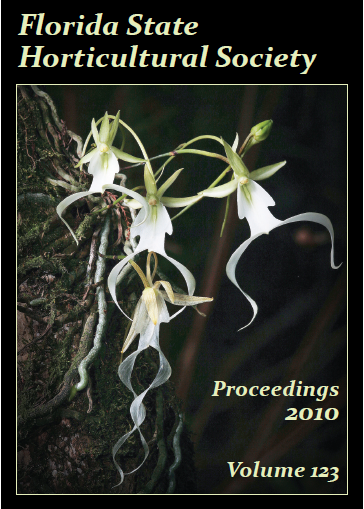Handling & Processing
Published 2010-12-01
Keywords
- Xanthomonas citri subsp. citri,
- fruit grading,
- canker identification,
- fruit disinfestation sanitizers
Abstract
To assist in developing best postharvest practices for handling fruit with canker lesions, a survey was distributed in summers of 2008 and 2009 to better understand current practices. Approximately 60% of the surveys were returned each year, representing about 55% of total fresh fruit shipments. As expected, the percentage of fruit received from blocks certified canker free declined from 2008 to 2009 as canker spread within the state. Sodium o-phenylphenate was the fruit disinfestation sanitizer most used by 52% of the packers to decontaminate fruit in 2008, but its use declined to 47% in 2009. Use of peroxyacetic acid increased from 21% to 33% over the same period, while chlorine use dropped from 27% to 20%. Most (~50%) of the sanitizers were applied as the fruit were first wetted, but managers were switching more to applying as the fruit were washed or afterwards. For both years, an average of 22 human graders were stationed at different points on the packingline to evaluate each load, with most (83%) increasing to 27 graders when fruit was known to come from a block with canker infection. All but one respondent reported that electronic graders were not useful for removing fruit with canker symptoms. In 2009, packers estimated that 34% of the citrus crop normally packed for the European Union market was disqualified because of canker and that 12% of the product packed for the domestic or Japanese markets was either disqualified, or contained sufficient canker infection to make unprofitable to pack for the fresh market.References
- Code of Federal Regulation (CFR) Title 7, Part 301.75 Subpart-citrus canker. <http://ecfr.gpoaccess.gov/cgi/t/text/text-idx?c=ecfr&sid=0bb3af1471eb7e526cb1d1b070d47a1a&rgn=div6&view=text&node=7:5.1.1.1.2.11&idno=7Fla>.
- Florida Department of Citrus. 2010. Florida’s Fresh Citrus Shipments 2009–10. Econ. and Mkt. Res. Rpt. No. FS-09/10-52 (Final Rpt.). 12 Dec. 2010. <http://www.fdocgrower.com/emr/shipmentsfresh.php>.
- Gottwald, T., J. Graham, C. Bock, G. Bonn, E. Civerolo, M. Irey, R. Leit f, G. McCollum, P. Parker, J. Ramallo, T. Riley, T. Schubert, B. Stein, and E. Taylor. 2009. The epidemiological significance of post-packinghouse survival of Xanthomonas citri subsp. citri for dissemination of Asiatic citrus canker via infected fruit. Crop Protection 28:508–524.
- Graham, J.H., T.R. Gottwald, and R.P. Leite. 2006. Prospects for control of citrus canker with novel chemical compounds. Proc. Fla. State Hort. Soc. 119:82–88.
- Narciso, J. 2005. An assessment of methods to clean citrus fruit surfaces. Proc. Fla. State Hort. Soc. 118:437–440.
- Qin, J., T.F. Burks, M.A. Ritenour, and G.W. Bonn. 2009. Detection of citrus canker using hyperspectral reflectance imaging with spectral information divergence. J. Food Eng. 93(2):183–191.
- Ritenour, M., J. Graham, and J. Narciso. 2008. Managing citrus canker for the fresh fruit industry. Citrus Ind. 89(10):20–22. Southeast AgNET Publ.
- Shiotani, H., H. Uematsu, T. Tsukamoto, Y. Shimizu, K. Ueda, A. Mizuno, and S. Sato. 2009. Survival and dispersal of Xanthomonas citri pv. citri from infected Satsuma mandarin fruit. Crop Protection 28 28:19–23.
- USDA APHIS. 2009a. An updated evaluation of asymptomatic citrus fruit (Citrus spp.) as a pathway for the introduction of citrus canker disease (Xanthomonas axonopodis pv. citri). U.S. Dept. of Agriculture, Animal and Plant Health Inspection Service, Plant Protection and Quarantine, Center for Plant Health Science and Technology, Plant Epidemiology and Risk Analysis Laboratory, Raleigh, NC.
- USDA APHIS. 2009b. Citrus canker; movement of fruit from quarantined areas. 7 CFR Part 301. Federal Register 74(203)54431–54445.
- USDA PPQ. 2010. Treatment manual—Domestic treatments. 7 Dec. 2010. <http://www.aphis.usda.gov/import_export/plants/manuals/online_manuals.shtml>.

